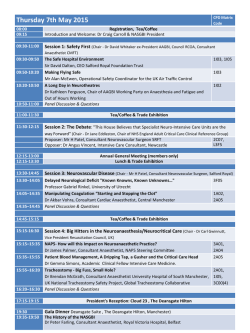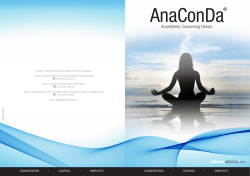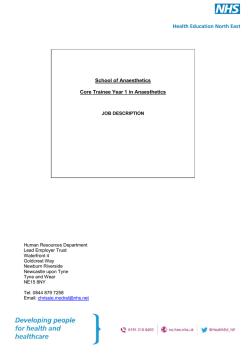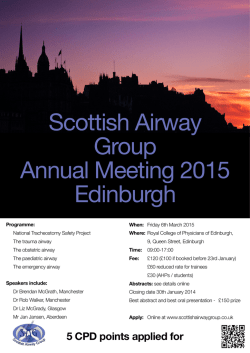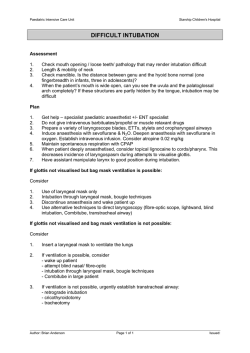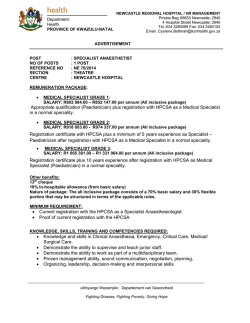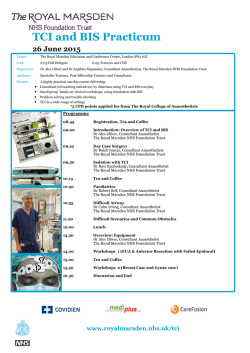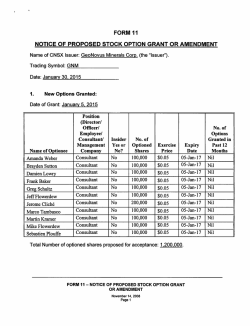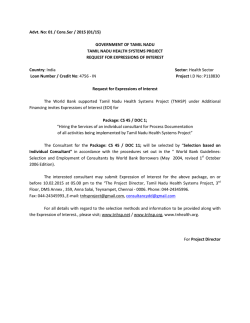
Guidance on the provision of obstetric anaesthesia services 2015
Chapter 9 GUIDELINES FOR THE PROVISION OF anaesthetic services Obstetric anaesthesia services 2015 Authors Dr M C Mushambi, Leicester Royal Infirmary Dr F S Plaat, Queen Charlottes and Chelsea Hospital, London In association with the Obstetric Anaesthetists’ Association (OAA) When considering the provision of anaesthesia, the Royal College of Anaesthetists recommends that the following areas should be addressed. The goal is to ensure a comprehensive, quality service dedicated to the care of patients and to the education and professional development of staff. The provision of adequate funding to provide the services described should be considered. These recommendations form the basis of the standard expected for departmental accreditation. www.rcoa.ac.uk/gpas2015 [email protected] CHAPTER 9 Guidance on the provision of obstetric anaesthesia services 2015 Summary ■■ ■■ ■■ ■■ ■■ ■■ ■■ ■■ ■■ ■■ Many of the following points are drawn from the joint Obstetric Anaesthetists’ Association (OAA) and Association of Anaesthetists of Great Britain and Ireland (AAGBI) ‘Guidelines for Obstetric Anaesthesia Services’ (2013).1 A duty anaesthetist must be immediately available for emergency work on the delivery suite 24 hours a day and there should be a clear line of communication from the duty anaesthetist to the supervising consultant at all times.1,2 Each obstetric unit should have a nominated consultant in charge of obstetric anaesthesia services with programmed activities (PAs) allocated for this, in addition to those for clinical ‘sessions’. As a basic minimum for any consultant-led obstetric unit, there should be ten consultant anaesthetic sessions per week (two per day), and where elective lists are run daily this would mean at least 15 sessions per week.3 One ‘session’ is defined as equivalent to 1.25PAs. There should be a named consultant anaesthetist with responsibility for planned caesarean section lists. Separate provision of staffing and resources should be available to allow elective work to continue uninterrupted by emergency work. Each obstetric unit with an anaesthetic service should have a nominated consultant anaesthetist responsible for training in obstetric anaesthesia. A process should be in place for the formal assessment of trainees prior to allowing them to go ‘on-call’ for obstetric anaesthesia with distant supervision.2 As part of revalidation, all anaesthetists involved in the delivery of obstetric services must ensure that their own knowledge and skills are kept up to date by undertaking appropriate continuing professional development activities.4 Antenatal education: women should have access to information, in an appropriate language, about all types of analgesia and anaesthesia available, including information about related complications. Patient information leaflets are available at: www.oaa-anaes.ac.uk. Guidelines should be available to obstetricians and midwives on conditions requiring antenatal referral to the anaesthetist. There should be at least one fully equipped and fully staffed obstetric theatre within the delivery suite.5 1 Guidelines for obstetric anaesthetic services. OAA and AAGBI, London 2013 (http://bit.ly/NzO9Xz). 2 The Curriculum for a CCT in Anaesthetics (2nd Edition). RCoA, London 2010 (www.rcoa.ac.uk/node/1462). 3 Guidelines for obstetric anaesthetic services (Revised Edition). OAA and AAGBI, London 2005 (http://bit.ly/NzNPYL). 4 Continuing professional development: guidance for doctors in anaesthesia, intensive care and pain medicine. RCoA, London 2013 (www.rcoa.ac.uk/node/1922). 5 Staffing of obstetric theatres – a consensus statement. College of Operating Department Practitioners, Royal College of Midwives and Association for Perioperative Practice. CoDP, London 2009 (http://bit.ly/1jM6Xhg). 1 Guidelines for the Provision of Anaesthetic Services 2015 CHAPTER 9 Guidance on the provision of obstetric anaesthesia services 2015 ■■ ■■ ■■ ■■ ■■ Parturients requiring anaesthesia have the right to the same standards of peri-operative care as other surgical patients. Skilled anaesthetic assistance and post-anaesthetic recovery care are of particular importance in obstetrics. Anaesthetists should help organise and participate in regular multidisciplinary ‘fire drills’ of emergency situations including major haemorrhage, eclampsia, failed intubation and maternal collapse and multidisciplinary courses.6,7 Appropriate facilities and trained staff should be available for the management of the sick obstetric patient.8 Access to Level 3 critical care must be available for all obstetric patients and preferably available on site. Portable monitoring with facility for invasive monitoring must be available to facilitate safe transfer of obstetric patients to the ICU. Anaesthetists should have some managerial responsibility and should be involved in planning decisions that affect the delivery of maternity services. Introduction: the importance of obstetric anaesthesia services ■■ Anaesthetists are involved in the care of over 60% of pregnant women.9 ■■ There have been changes in staffing, training and working time legislation affecting obstetric anaesthetic services.10,11,12 Obstetric anaesthetic consultants are increasingly involved in the assessment of patients, teaching, training, administration, research and audit.12,13 ■■ There is a need for a dedicated obstetric anaesthesia service for all consultant-led obstetric units. The anaesthetic pre-assessment of high risk women necessitates the early involvement of senior anaesthetists and transfer to intensive care facilities for high risk cases.8,14,15 This is supported by the Clinical Negligence Scheme for Trusts (CNST).6 6 Clinical negligence scheme for trusts 2011/2012. Maternity clinical risk management standards. Version 1. NHSLA, London 2012 (http://bit.ly/OSYleQ). 7 O’Herlihy C. Saving mothers’ lives. Reviewing maternal deaths to make motherhood safer: 2006–2008. BJOG 2011;118:1404– 1404. 8 Providing equity of critical care and maternity care for the critically ill pregnant or recently pregnant woman. RCoA, London 2011 (www.rcoa.ac.uk/node/1857). 9 Anaesthesia under examination: the efficiency and effectiveness of anaesthesia and pain relief services in England and Wales. Report for the National Audit Commission. The Audit Commission, London 1997 (http://bit.ly/1jM7q3c). 10 Hours of work of doctors in training: working arrangements of doctors and dentists in training. In: Junior Doctors – the New Deal. NHS Management Executive, London 1991. 11 The European Working Time Directive – UK notification of derogation for doctors in training. DH, London 2009 (http:// bit.ly/1jM840t). 12 Survey of obstetric anaesthetic workload. OAA and AAGBI, London 2011 (http://bit.ly/1jM89RR). 13 Wee MYK, Yentis SM, Thomas P. Obstetric anaesthetists’ workload. Anaesth 2002;57:484–500. 14 Why Mothers Die 1997–1999. The Confidential Enquiries into Maternal Deaths in the United Kingdom. RCOG Press, London 2002 (http://bit.ly/1jM8jZE). 15 Why Mothers Die 2000–2002. The Confidential Enquiries into Maternal Deaths in the United Kingdom. RCOG Press, London 2004 (http://bit.ly/1jM8qUU). The Royal College of Anaesthetists 2 CHAPTER 9 Guidance on the provision of obstetric anaesthesia services 2015 ■■ In the UK, the caesarean section rate, incidence of obesity, age of parturients and number of parturients with medical conditions are increasing.16,17,18 ■■ Anaesthetic delay can be a factor in some poor neonatal outcomes, stillbirths and infant deaths.19,20 ■■ There have been concerns about the staffing of isolated obstetric units, the level of experience of on-call anaesthetic staff, and the reduction of exposure to emergency general anaesthesia in obstetrics.15,21 Levels of provision of service 1 Staffing requirements The duty anaesthetist 16 1.1 The term ‘duty anaesthetist’ will henceforth be used to denote an anaesthetist who has been assessed as competent to undertake duties on the delivery suite under a specified degree of supervision. 1.2 The duty anaesthetist should be immediately available for the obstetric unit 24 hours per day. The duty anaesthetist should not be primarily responsible for elective obstetric work. There should be a clear line of communication from the duty anaesthetist to the supervising consultant at all times and consultant support and on-call availability are essential 24 hours per day.1,2 1.3 In the busier units it may be necessary to have two duty anaesthetists available 24 hours per day, in addition to the supervising consultant. 1.4 In units that offer a 24-hour epidural service, the duty anaesthetist should be resident on site, i.e. not at a nearby hospital. 1.5 If the duty anaesthetist has other responsibilities, these should be of a nature that would allow the activity to be delayed or interrupted should obstetric work arise, to allow provision of analgesia, as well as anaesthesia, to parturients. 1.6 Although the difficulties of smaller units are appreciated, it is strongly recommended that the duty anaesthetist for the delivery suite should not be solely responsible for the ICU or cardiac arrests as that anaesthetist could be urgently required in two places simultaneously. Equally, if the duty anaesthetist covers general theatres, there must be another anaesthetist to take over immediately should they be needed on the delivery suite. The lead clinician should audit and monitor the feasibility of such arrangements. 1.7 Where duty anaesthetists work on a shift pattern, adequate time for formal handover between shifts must be built into the timetable. Ideally, the timetable of different professional groups should be compatible, for example anaesthetic and obstetric shifts should start and finish at the same time to allow multidisciplinary handover. The duty anaesthetist should participate in delivery suite ward rounds. See information from the Academy of Medical Royal Colleges (http://bit.ly/1cnCc2P). The National Sentinel Caesarean Section Audit Report. RCOG Clinical Effectiveness Support Unit. RCOG Press, London 2001 (http://bit.ly/1jM8x2P). 17 Caesarean section guidelines (CG132). NICE, London 2011 (updated from 2004) (www.nice.org.uk/Guidance/cg132). 18 Maternal obesity in the UK: findings from a national project. CMACE, London 2010 (http://bit.ly/1jM8Ryu). 19 Confidential Enquiry into Stillbirths and Deaths in Infancy (CESDI). 7th Annual Report. Maternal and Child Health Research Consortium, London 2000. 20 Davies JM et al. Liability associated with obstetric anaesthesia. A closed claim analysis. Anesthesiol 2009;110:131–139. 21 Johnson RV et al. Training in obstetric general anaesthesia: a vanishing art? Anaesth 2000;55:179–183. 3 Guidelines for the Provision of Anaesthetic Services 2015 CHAPTER 9 Guidance on the provision of obstetric anaesthesia services 2015 Consultant responsibilities 1.8 Each obstetric unit should have a nominated consultant in charge of obstetric anaesthesia services with programmed activities (PAs) allocated for this, in addition to those for direct patient care. The nominated consultant should be responsible for the organisation and audit of the service, for maintaining and raising standards, through provision of evidencebased guidelines, and for risk management. 1.9 The number of consultant sessions required should reflect the obstetric anaesthetic workload and not just the number of deliveries per annum. It needs to take into account the regional anaesthesia rate (which includes all procedures under regional anaesthesia and not just epidurals for labour analgesia) as well as other clinical activities such as clinics, HDU workload and procedures under general anaesthesia and non-clinical activities.22 As a basic minimum for any consultant-led obstetric unit, there should be ten consultant anaesthetic daytime sessions (1 session = 1.25 PAs on average) per week1 and these should be spread evenly throughout the working week. 1.10 Extra consultant PAs/sessions should be available to units which are busier than average, tertiary referral units, which are likely to have a higher than average proportion of high risk women, units in which trainee anaesthetists work a full or partial shift system, where the provision of additional consultant PAs should be considered to allow training and supervision into the evening.23,24 The number of such additional hours should be increased where there is a high turnover of trainees, i.e. a three-month interval or more frequent. There should be at least one consultant PA available per week for antenatal referrals whether or not a formal clinic is run. 1.11 There should be a named consultant responsible for every elective caesarean section operating list. This consultant should not be rostered for any other timetabled activity. 100% of elective CS under GA should be used for teaching GA skills (see Joy S, Wilson R. Airway and intubation problems during general anaesthesia for CS). 1.12 Separate provision of staffing and resources should be available to allow elective work to continue uninterrupted by emergency work. 1.13 Anaesthesia for elective caesarean sections should only be performed by trainees in isolated units when there is a consultant anaesthetist available to provide local supervision.2 1.14 When a formal elective caesarean section list is covered by a consultant there should be a separate consultant available in the delivery suite.1 1.15 The on-call consultant should not be more than half an hour away from the delivery suite at any time. The names of all consultants covering the delivery suite should be prominently displayed and contact numbers readily available. 1.16 It is part of the lead consultant obstetric anaesthetist’s role to ensure there is an ongoing audit programme in place to audit complication rates.25 22 Yentis SM, Robinson PN. Definitions in obstetric anaesthesia: how should we measure anaesthetic workload and what is ‘epidural rate’? Anaesth 1999;54:958–962. 23 Working time directive 2009 and shift working – ways forward for anaesthetic services, training doctors and patient safety. RCoA, London 2007 (www.rcoa.ac.uk/node/3066). 24 Safer Childbirth. Minimum standards for the organisation and delivery of care in labour. Royal College of Anaesthetists, Royal College of Nursing, Royal College of Obstetricians and Gynaecologists and Royal College of Paediatrics and Child Health. RCoA, London 2007 (www.rcoa.ac.uk/node/2282). 25 Raising the standard: a compendium of audit recipes (3rd Edition). RCoA, London 2012 (www.rcoa.ac.uk/node/8640). The Royal College of Anaesthetists 4 CHAPTER 9 Guidance on the provision of obstetric anaesthesia services 2015 Anaesthetic assistance 1.17 Parturients requiring anaesthesia have the right to the same standards of peri-operative care as all other surgical patients. Skilled anaesthetic assistance is of particular importance in obstetrics. 1.18 In the United Kingdom, anaesthetic assistance may be provided by an operating department practitioner or nurse (ODP/N) or a registered nurse. Whatever the background, the training for all anaesthetic assistants, including midwives, must comply fully with current national qualification standards. Employment of anaesthetic assistants without national accreditation is unacceptable.26 1.19 The anaesthetic assistant should assist the anaesthetist on a regular basis, not only occasionally, to ensure maintenance of competence. Such a person thus employed should have no other duties in the operating department at that time, and the midwife attending the mother and baby cannot also assist the anaesthetist. 1.20 Post-anaesthetic recovery staff The training undergone by staff in recovery, whether these are midwives, nurses or ODP/ Ns, must be to the level recommended for general recovery facilities.5,26,27 A midwife with no additional training is not adequately trained for recovery duties. 1.21 Other members of the team A trained adult and neonatal resuscitation team must be available. 1.22 There should be adequate secretarial support for the antenatal anaesthetic assessment clinic and other duties of the consultant obstetric anaesthetist – teaching, research, audit, appraisal activities and other administrative work. 1.23 There should be a suitably trained and named senior member of nursing, midwifery or ODP staff with overall responsibility for the safe running of obstetric theatres, who ensures that current standards in all aspects of theatre work are met. He or she must have considerable experience of working in theatre and must undertake the role on a regular basis. This individual should ensure all staff who work in theatre are appropriately trained and undergo regular appraisal and continuing professional development (CPD). 2 Equipment, support services and facilities For the efficient functioning of the obstetric anaesthetic service, the following equipment, support services and facilities are essential. The standards of equipment and monitoring must be of the same standard as that of a non-obstetric anaesthetic service. Equipment 2.1 Blood gas analysis (with facility to measure serum lactate) and the facility for rapid estimation of haemoglobin (for example HemoCue®) and blood sugar should be available on the delivery suite. In tertiary units, with a high risk population, it is recommended that there should be equipment to enable bedside estimation of coagulation such as thromboelastography (TEG) or thromboelastometry (ROTEM).28 2.2 The delivery suite rooms must be equipped with monitoring equipment for the measurement of non-invasive blood pressure. There must also be readily available equipment for monitoring electrocardiogram (ECG), oxygen saturation, temperature and invasive haemodynamic monitoring if required. 26 Immediate post-anaesthesia recovery. AAGBI, London 2013 (http://bit.ly/1jM9CaU). 27 The anaesthesia team 3. AAGBI, London 2010 (http://bit.ly/1d0b8nT). 28 Blood transfusion and the anaesthetist. Management of massive haemorrhage. AAGBI, London 2010 (http://bit.ly/1jM9OXw). 5 Guidelines for the Provision of Anaesthetic Services 2015 CHAPTER 9 Guidance on the provision of obstetric anaesthesia services 2015 2.3 All delivery suite rooms must have oxygen, suction equipment and access to resuscitation equipment. 2.4 Delivery suite rooms should have scavenging of waste anaesthetic gas to comply with COSHH and guidelines on workplace exposure limits on anaesthetic gas pollution.29,30 2.5 A supply of O-rhesus negative blood should be available to the delivery suite at all times for emergency use. In addition, a system of rapid access to blood and blood products should be available in agreement with the hospital’s Blood Transfusion Service (see major haemorrhage section below). 2.6 The standard of monitoring in the obstetric theatre must allow the conduct of safe anaesthesia for surgery as detailed by the AAGBI standards of monitoring.31 2.7 A blood warmer allowing the rapid transfusion of blood and fluids must be available. A Level 1 or equivalent rapid infusion device should be available for the management of major haemorrhage. 2.8 A cell salvage service should be available for massive blood loss and Jehovah’s Witness parturients.32 And there should be staffed trained and experienced in using it. 2.9 Warming devices such as warm air blowers or heated mattresses should also be available to prevent inadvertent hypothermia. 2.10 A difficult intubation trolley with a variety of laryngoscopes including video laryngoscopes, tracheal tubes, laryngeal masks, including second generation supraglottic airway devices, and other aids for airway management must be available in theatre. The difficult intubation trolley should have a standard layout which is similar to trolleys in other parts of the hospital so that users will find the same equipment and layout in all sites.33 2.11 Patient controlled analgesia (PCA) equipment and infusion devices must be available for post- operative pain relief as well as for labour pain. 2.12 The maximum weight that the operating table can support must be known and alternative provision made for women who exceed this. It is recommended that the obstetric operating table should be able to safely support a minimum weight of 160 kilograms in all positions. 2.13 Equipment to facilitate the care of the morbidly obese parturient including specialised electrically operated beds, aids such as commercially produced ramping pillows to assist patient positioning, weighing scales, sliding sheets and hoists, should be readily available and staff should receive training on how to use the specialist equipment.34 29 Occupational exposure limits (EH40/96). Health and Safety Executive. HMSO, London 1996. 30 List of Workplace Exposure Limits (WELs) and other tables (HSC/04/06 Annexe C). HSE, London 2004 (http://bit.ly/1vDGyWD). 31 Recommendations for standards of monitoring during anaesthesia and recovery. AAGBI, London 2007 (http://bit.ly/1jM9WWZ). 32 Blood transfusion and the anaesthetist. Intra-operative cell salvage. AAGBI, London 2009 (http://bit.ly/1jMa3Ca). 33 Cook T, Woodall N, Frerk C. Major complications of airway management in the UK. Report and findings. The 4th National Audit project of The Royal College of Anaesthetists and the Difficult Airway Society. RCoA, London 2011 (www.rcoa.ac.uk/node/364). 34 Peri-operative management of the morbidly obese patient. AAGBI, London 2007 (http://bit.ly/1jMaex9). The Royal College of Anaesthetists 6 CHAPTER 9 Guidance on the provision of obstetric anaesthesia services 2015 2.14 Ultrasound imaging equipment should be available for central vascular access, transversus abdominis plane (TAP) blocks and epidural procedures of parturients, as well as high risk and morbidly obese women.35,36 2.15 Accurate clocks should be available in all delivery rooms and theatres for the recording of events and to comply with medico-legal requirements.37 2.16 Resuscitation equipment including a defibrillator must be available on the delivery suite and should be checked regularly.1 Support services 2.17 A system should be in place to ensure that women requiring antenatal referral to the anaesthetist are seen and assessed by a senior anaesthetist within a suitable time frame, preferably in early pregnancy. Ideally, this should be in the form of a multidisciplinary team management of these high risk women. 2.18 All women requiring caesarean section should, except in extreme emergency, be visited and assessed by an anaesthetist before arrival in the operating theatre. Ideally, women should be seen at least 24 hours prior to elective surgery where pre-assessment, provision of information including printed material, and consent for anaesthesia is obtained. 2.19 There should be arrangements or standing orders for prescription of pre-operative antacid prophylaxis and for laboratory investigations. 2.20 Haematology and biochemistry services must be available to provide rapid analysis of blood and other body fluids. 2.21 A local policy should be established with the haematology department to ensure blood and blood products are readily available for the management of major haemorrhage.28 This should be updated regularly to follow the latest guidelines on the management of massive haemorrhage.38,39 2.22 In order that blood can be made available within the time frames stipulated, the transfusion laboratory should be situated on the same site as the maternity unit.1 2.23 There must be rapid availability of radiological services. In tertiary referral centres, 24hour access to interventional radiology services is highly recommended.1 2.24 Pharmacy services are required for the provision of necessary routine and emergency drugs. 2.25 The provision of sterile pre-mixed low dose local anaesthetic combined with opioid solutions for regional analgesia should be available, as well as other sterile opioid solutions used for patient controlled analgesia. 2.26 In order to minimise the risk of inadvertent intravenous administration of local anaesthetic and opiate solutions intended for epidural use, these must be stored separately from intravenous fluid.1 35 Guidance on the use of ultrasound locating devices for placing central venous catheters (Technology Appraisal No 49). NICE, London 2002 (http://bit.ly/1jMak7T). 36 Ultrasound-guided catheterisation of the epidural space (IPG249). NICE, London 2008 (www.nice.org.uk/guidance/ipg249). 37 Sehgal A, Bamber J. Different clocks, different times. Anaesth 2003;58:398. 38 Sambasivan CN, Schreiber MA. Emerging therapies in traumatic haemorrhage control. Curr Opin Crit Care 2009;15:560–568. 39 Hess JR et al. Giving plasma at a 1:1 ratio with red cells in resuscitation: who might benefit? Transfusion 2008;48:1763– 1765. 7 Guidelines for the Provision of Anaesthetic Services 2015 CHAPTER 9 Guidance on the provision of obstetric anaesthesia services 2015 2.27 Intralipid, sugammadex and dantrolene must be kept on the delivery suite and their location should be clearly identified. 2.28 Physiotherapy services should be available 24 hours a day, 365 days a year, for patients requiring high dependency care. 2.29 All women who have received regional analgesia/anaesthesia or general anaesthesia for labour and delivery should be reviewed following delivery. Women must fulfil locally agreed discharge criteria before going home. Facilities 2.30 There must be easy and safe access to the delivery suite from the main hospital at all times of the day. 2.31 There should be at least one fully equipped obstetric theatre within the delivery suite. The number of operating theatres required should depend on the number of deliveries and operative risk profile of the women delivering in the unit. 2.32 An operating theatre with appropriately trained staff must be readily available for women requiring emergency caesarean section.5 The standard of monitoring in all obstetric theatres must meet the minimum AAGBI monitoring standards.31 2.33 Adequate recovery room facilities, including the ability to monitor systemic blood pressure, ECG, oxygen saturation and end-tidal carbon dioxide, must be available within the delivery suite theatre complex.31,33 2.34 Medical physics technicians are required to maintain, repair and calibrate anaesthetic machines, monitoring and infusion equipment. 2.35 All units should have facilities and equipment to provide high dependency care (Level 2) for high risk obstetric patients with appropriately trained staff or, if this is unavailable, women should be transferred to an HDU in the same hospital.8 2.36 All patients must be able to access Level 3 critical care if required; units without such provision on site must have an arrangement with a nominated Level 3 critical care unit and an agreed policy for the stabilisation and safe transfer of patients to this unit when required.1,8 Portable monitoring with facility for invasive monitoring must be available to facilitate safe transfer of obstetric patients to the ICU.40 2.37 An anaesthetic office, in proximity to the delivery suite, should be available to the duty anaesthetic team. The room should have a computer with intra/internet access for the audit of the anaesthetic service, for accessing emails and e-learning facilities, and access to up-to-date information. A library of specialist reference books and/or journals and local multidisciplinary evidence-based guidelines must be available. The office space, facilities and furniture should comply with the standards recommended by the AAGBI guidelines.41 2.38 There should be a separate anaesthetic consultant’s office available to allow teaching, assessment and appraisal and it should comply with AAGBI guidelines.41 2.39 A communal rest room in the delivery suite should be provided to enable staff of all specialties to meet. A seminar room(s) must be available for training, teaching and multidisciplinary meetings. 40 Interhospital transfer. AAGBI, London 2009 (http://bit.ly/1jMaNqQ). 41 Department of anaesthesia: secretariat and accommodation. AAGBI, London 1992 (http://bit.ly/1jMaTi8). The Royal College of Anaesthetists 8 CHAPTER 9 Guidance on the provision of obstetric anaesthesia services 2015 2.40 All hospitals should ensure the availability of areas that allow those doctors working night shifts, to take rest breaks essential for the reduction of fatigue and improve safety.1,41,42,43 These areas should not be shared by more than one person at a time and allow the doctor to fully recline 2.41 Standards of accommodation for doctors in training must be adhered to.44,45 Where a consultant is required to be resident, appropriate on-call accommodation should be provided. 2.42 Hotel services must provide suitable on-call facilities including housekeeping for resident and non-resident anaesthetic staff. Refreshments must be available throughout the 24hour period. 2.43 Guidelines All obstetric departments should provide and regularly update multidisciplinary guidelines to comply with CNST standards.6 A comprehensive list of recommended guidelines can be found in the OAA/AAGBI Guidelines for Obstetric Anaesthesia Services.1 3 Areas of special requirement Regional and opioid analgesia 3.1 Most consultant obstetric units should be able to provide regional analgesia on request at all times. Smaller units may be unable to supply dedicated cover at all times; women booking at such units should be made aware that epidural analgesia may not always be available. 3.2 The anaesthetist is responsible for ongoing regional analgesia in labour and must be able to assess the mother as required. 3.3 Midwifery care of a parturient receiving epidural analgesia in labour should comply with local guidelines. The midwife must be trained to an agreed standard in regional analgesia and be aware of potential complications and their management. The midwife should regularly care for parturients with regional analgesia and receive regular updates in training. If the level of midwifery staffing is considered inadequate, epidural block should not be provided. 3.4 There should be appropriate levels of medical and midwifery staff for the safe delivery of epidural analgesia for labour service. Units should be able to provide low dose regional analgesia.46 3.5 Regional analgesia should not be used in labour unless an obstetric team is immediately available in the same hospital to treat emergencies. 3.6 There should be a locally agreed regional analgesia record and a protocol for the prescription and administration of epidural drugs. 3.7 The time from the anaesthetist being informed about an epidural until they are able to attend the mother should not normally exceed 30 minutes, and must be within one hour. This should be an auditable standard.25 42 Fatigue and anaesthetists (currently under review). AAGBI, London 2013 (http://bit.ly/1jMb8K5). 43 Anaesthetic service accommodation in district general hospitals. A design guide. DHSS, London 1971. 44 Living and working conditions for hospital doctors in training. Circular HSS(TC8)1/2002. DHSS, London 2002 (http:// bit.ly/1jMbj8a). 45 Fatigue and Anaesthetists (expanded web version). AAGBI, London 2005 (http://bit.ly/1hUuISj). 46 Comparative obstetric mobile epidural trial (COMET) study group UK. Effect of low-dose mobile versus traditional epidural techniques on mode of delivery: a randomised controlled trial. Lancet 2001;358:19–23. 9 Guidelines for the Provision of Anaesthetic Services 2015 CHAPTER 9 Guidance on the provision of obstetric anaesthesia services 2015 3.8 Where remifentanil PCA is provided as an alternative to regional analgesia, there should be agreed multidisciplinary guidelines and midwifery training as well as the supply of appropriate equipment and drugs to provide this service. 3.9 It is essential that midwives looking after women on remifentanil PCA are trained and stay with the parturient continuously without any break in observation. Remifentanil PCA should only be used in units where it is frequently and regularly used. Rapid reversal of respiratory depression/arrest and airway resuscitation equipment should be immediately available. Emergency caesarean sections 3.10 There should be a clear line of communication between the duty anaesthetist, theatre staff and ODP/N once a decision is made to undertake an emergency caesarean section. The anaesthetist should be informed about the category of urgency of caesarean section and a modified WHO checklist should be used in theatre.47,48 3.11 There should be clear guidelines available for whom to call if two emergencies occur simultaneously. Anaesthetists in other parts of the hospital may need to be summoned if the second anaesthetist is attending from home. Maternal critical care 3.12 NICE guidance on the recognition and response to acute illness in adults in hospitals should be implemented.49 The CEMACH report recommended the introduction of the modified early obstetric warning scores (MEOWS) in all obstetric in-patients to aid early recognition and treatment of the acutely ill parturient.50 A graded response for patients identified as being at risk of clinical deterioration should be agreed and delivered locally.8 3.13 All units that care for high risk patients should be able to access Level 2 high dependency care on site. Where Level 2 care is provided on the maternity unit, appropriately trained staff should be available 24 hours a day to provide high dependency care. Midwives working in this setting should have additional training to equip them with the necessary critical care competencies.8 3.14 There should be a named consultant and obstetrician responsible for all Level 2 patients 24 hours a day. 3.15 If concerns arise regarding critical illness in an obstetric patient and the obstetric anaesthetist lacks appropriate intensive care skills, they should consult an intensive care colleague for specialist advice at an early stage.14,15 3.16 Complaints If complaints are made about aspects of care, a consultant anaesthetist should review and assess the mother’s complaint, discussing her concerns and examining her where appropriate. This should be documented. Referral for further investigations may be required. Complaints should be handled according to local policies. The lead obstetric anaesthetist should be made aware of all patient complaints. 47 Lucas DN et al. Urgency of caesarean section: a new classification. J Roy Soc Med 2000;93:346–350. 48 Haynes AB et al. The safe surgery saves lives study group. A surgical safety checklist to reduce morbidity and mortality in a global population. N Engl J Med 2009;360:491-499. 49 Acutely ill patients in hospital (CG50). Recognition of and response to acute illness in adults in hospital. NICE, London 2007 (www.nice.org.uk/CG50). 50 Lewis G. (Ed) Saving mothers lives: reviewing maternal deaths to make motherhood safer 2003–2005. The 7th confidential enquiry into maternal deaths in the United Kingdom. CEMACH, London 2007. The Royal College of Anaesthetists 10 CHAPTER 9 Guidance on the provision of obstetric anaesthesia services 2015 4 Training and education 4.1 Each obstetric unit with an anaesthetic service should have a nominated consultant responsible for training in obstetric anaesthesia. Adequate PAs should be allocated for these responsibilities.1 4.2 An appropriate training program should be in place for anaesthetic trainees according to their grade and the curriculum.2,51,52,53 4.3 A process should be in place for the formal assessment of trainees prior to allowing them to go on-call for obstetric anaesthesia with distant supervision.2,51 This assessment applies to: ■■ ST1s and ST2s new to obstetric anaesthesia ■■ more experienced trainees who are working in the UK for the first time ■■ newly appointed STs who have not successfully completed a formal assessment. 4.4 The successful completion of the initial assessment of competence in obstetric anaesthesia (IACOA) is mandatory for all core trainees before they are considered safe to work in an obstetric unit without direct supervision.51 4.5 Simulation-based learning techniques should be used to assist anaesthetists to develop non-technical skills required to work safely and effectively within the multidisciplinary obstetric team.54,55 4.6 There should be induction programmes for all new members of staff including locums. Locums should be assessed prior to undertaking unsupervised work. 4.7 As part of revalidation, all anaesthetists involved in the delivery of obstetric anaesthetic services must ensure that their own knowledge and skills are kept up to date by undertaking appropriate continuing professional development activities that reflect the needs of their ‘whole’ practice and their own learning needs.3,55 This includes both routine and out-of-hours clinical responsibility.3,55 4.8 Any non-trainee anaesthetist who undertakes anaesthetic duties in the labour ward must have been assessed as competent to perform these duties in accordance with OAA and RCoA guidelines.1,51 Such a doctor must work regularly in the labour ward but must also regularly undertake non-obstetric anaesthetic work to ensure maintenance of a broad range of anaesthetic skills. 4.9 Assistance for the anaesthetist should be trained to the standards recommended by the AAGBI.27 4.10 The recovery staff within a maternity unit should be trained to the same standard as that for all recovery nurses, whether they are ODPs or midwives.26 Recovery skills should be regularly updated with time spent in a general recovery unit. 4.11 All staff working on the delivery suite should have regular resuscitation training, including the specific problems of pregnant patients. 4.12 Anaesthetists should contribute to the education and update of midwives, ODAs, ODPs, anaesthetic nurses, physicians’ assistants (anaesthesia) and obstetricians, covering the scope and limitations of obstetric anaesthesia services. 51 The CCT in Anaesthetics (Annex B). Basic level training. RCoA, London 2010 (www.rcoa.ac.uk/node/1411). 52 The CCT in Anaesthetics (Annex C). Intermediate level training. RCoA, London 2010 (www.rcoa.ac.uk/node/1434). 53 The CCT in Anaesthetics (Annex D). Higher level training. RCoA London, 2010 (www.rcoa.ac.uk/node/1437). 54 Pratt S. Simulation in obstetrics anaesthesia. Anaesth Analg 2012;114:186–190. 55 Safe births: everybody’s business. An independent enquiry into the safety of maternity services in England. The Kings Fund, London 2008 (http://bit.ly/1jMd9WB). 11 Guidelines for the Provision of Anaesthetic Services 2015 CHAPTER 9 Guidance on the provision of obstetric anaesthesia services 2015 4.13 Anaesthetists should help organise and participate in regular multidisciplinary ‘fire drills’ of emergency situations including major haemorrhage, eclampsia, failed intubation and maternal collapse. They should also participate in multidisciplinary courses such as the PROMPT course.6,7 4.14 Maintenance of standards of post-operative care requires continuous update, and staff should work in a theatre recovery unit on a regular basis. 4.15 All staff must be given regular access to CPD opportunities.56 5 Research and audit 5.1 There should be an ongoing audit programme in place to audit anaesthetic complication rates (for example accidental dural puncture) and problems.25 5.2 Delays in elective cases should be audited.25 5.3 On-going audit of patient satisfaction with the obstetric anaesthetic service should be undertaken.25 5.4 Research in obstetric anaesthesia and analgesia, particularly those recognised by the National Institute for Health Research and National Institute for Academic Anaesthesia, should be encouraged. Research should follow strict ethical standards as recommended by the GMC.57 6 Organisation and administration 6.1 Care of the pregnant woman is delivered by teams rather than individuals. It has been shown that effective teamwork can increase safety while poor teamwork can jeopardise safety.50,55 It is, therefore, important that obstetric anaesthetists develop good working relationships and lines of communication with all other professionals, including those whose care may be needed for difficult cases. This includes midwives and obstetricians, as well as professionals from other disciplines such as intensive care, neurology, cardiology, haematology, radiology and other physicians and surgeons. 6.2 Team briefing and the WHO checklist should be used routinely on the labour ward to promote good communication and team working and reduce adverse incidents.47,48 6.3 An obstetric anaesthetist should take part in regular multidisciplinary ‘labour ward forum’ meetings.24 6.4 Units with high caesarean section rates should have elective caesarean section lists with dedicated obstetric, anaesthetic and theatre staff, to minimise disruption due to emergency work. 6.5 Anaesthetists must have some managerial responsibility and should be involved in planning decisions that affect the delivery of maternity services. Anaesthesia should be represented on the Maternity Services Liaison Committee, Delivery Suite Forum, Obstetric Multidisciplinary Guidelines Committee, Obstetric Risk Management Committee, Obstetric Directorate and any other bodies involved in the planning and delivery of such services.1,24 56 The CPD Matrix. RCoA, London 2013 (www.rcoa.ac.uk/node/1923). 57 Good practice in research and consent to research. GMC, London 2010 (http://bit.ly/1jMdsRa). The Royal College of Anaesthetists 12 CHAPTER 9 Guidance on the provision of obstetric anaesthesia services 2015 7 Patient information 7.1 Women and purchasers of services should be informed of the level of availability of anaesthesia and regional analgesia in each unit. Printed information leaflets should be used to provide up-to-date information to women requesting an epidural and other procedures before the arrival of the anaesthetist as part of the consenting process.58,59 7.2 Antenatal education: when feasible, women should have access to information, in an appropriate language, about all types of analgesia and anaesthesia available, including information about related complications. Access to multi-lingual patient information sites and leaflets should be readily available.58 7.3 There is no difference between the principle of obtaining consent for obstetric anaesthesia and any other medical treatment.59 NAP5 identified that the obstetric patient undergoing rapid sequence induction for Caesarean section has at higher risk of accidental awareness during general anaesthesia (AAGA). The risk of AAGA as well as other risks such as failed intubations which are higher in the obstetric patient should be communicated appropriately to patients as part of the consent process.60 7.4 The parturient is entitled to receive an explanation of the proposed procedure and its associated risks in appropriate language. Interpreters should be made available to women who do not speak English; when feasible these should not be family members.7 7.5 All explanations given to the parturient should be clearly documented in the notes. 7.6 The setting up of a patient advocate system should be encouraged. 58 Middle JV, Wee MYK. Informed consent for epidural analgesia: a survey of UK practice. Anaesth 2009;64(2):161–164. 59 Consent for anaesthesia 2. AAGBI, London 2006 (http://bit.ly/1jMdJUg). 60 Plaat F, Lucas N, Bogod DG. AAGA in obstetric anaesthesia. In: Accidental Awareness during General Anaesthesia in the United Kingdom and Ireland (pg 133-143). 5th National Audit Project (NAP5) of the Royal College of Anaesthetists and Association of Anaesthetists of Great Britain and Ireland 2014 (http://bit.ly/1ztyQVx). 13 Guidelines for the Provision of Anaesthetic Services 2015
© Copyright 2025
